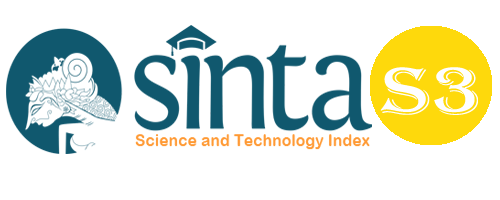Inheriting Tradition: Acculturation at the Naek Ayun Ceremony of Kutai Community in Kutai Kartanegara Regency
Abstract
The Naek Ayun ceremony which is thought to be a legacy of pre-Islamic traditions is still practiced by the Kutai people in Kutai Kartanegara Regency, who are generally Muslim.The continuity of the pre-Islamic tradition to date is the result of negotiations and acculturation between pre-existing cultures and Islam.This study was conducted to see the forms of cultural crossing or acculturation that occurred and the meaning of the ceremony for the participants in the present. The field research was conducted in Tenggarong District, Kutai Kartanegara Regency, using a qualitativedescriptive method.Based on the results of this study, it can be predicted that the existence of the Naek Ayun ceremony which has its roots in pre-Islamic times willcontinue in the future.The procession and meaning of the Naek Ayun ceremony are inherited by the new generation dynamically through the stages of being processed, created, and renewed with the tasmiyah ceremony.The general meaning behind the series of activities and symbols of the Naek Ayun ceremony is an expression of gratitude to God for the grace that has been bestowed uponthe society.In addition, the Naek Ayun ceremony means maintaining good relations between humans and their environment.
Keywords
Full Text:
PDFReferences
Ahimsa-Putra, H.S. (2015). SeniTradisi, Jatidiri dan Strategi Kebudayaan. JurnalIlmuSosialMamangan, Volume 2, Nomor 1, Januari-Juni 2015
---- (2016). “Kearifanlokal dan JatidiriBangsa, Pengalaman Indonesia”. LembaranAntropologiBudaya. Vol.1, Nomor 1, April.
---- (2020). “Mendefinisikan Kembali Kebudayaan”. LembaranAntropologiBudaya. Vol.2, Nomor 2, Desember.
Astuti, H.J.P. (2017). Islam Nusantara; SebuahArgumentasiBeragamadalamBingkaiKultural. INJECT: Interdisciplinary Journal of Communication, Vol.2, No.1, Juni: h. 27-51
Azmidi. (2010). Tradisi Nae ayun Masyarakat Kutai Kartanegara. Dinas Kebudayaan dan PariwisataKabupaten Kutai Kartanegara.
Daulay, H.P. 2007. Sejarah pertumbuhan dan pambaruan Pendidikan Islam di Indonesia. Jakarta: Kencana
Hardjanto, Y.S., Naim, A., Aziz, A. (-) AnalisisKonteksPengetahuanTradisional dan EkspresiBudayaTradisionalBerbasisMuatanLokal di Kalimantan Timur. DirjenKebudayaanKemendikbud.
Marzali, A. (2016). Agama dan Kebudayaan.UMBARA : Indonesian Journal of Anthropology.Volume 1 (1) Juli 2016 eISSN 2528-1569 pISSN 2528-2115.
Muamara, R. &Ajmin, N. 2020. Akulturasi Islam dan Budaya Nusantara. Dalam Tanjak: Journal of Education and Teaching.ISSN 2716-4098 (P) 2720-8966 (O). Volume 1 Nomor 2, 2020.
Miharja, (2014). Persentuhan Agama Islam denganKebudayaanasli Indonesia. Dalam MIQOT Vol.XXXVIII No. 1 Januari-Juni.
Noname. undated. Salasilah Kutai.
Purba, N. (2020). The Use of Simalungun Language by Anak Boru Sanina in the Simalungun Wedding Ceremony (Sociolinguistic Studies). Lakhomi Journal: Scientific Journal of Culture. 1-7
Roibin. (2010). “Agama dan Budaya: KonfrontatifatauKompromistik?.” Jurnal Hukum dan Syariah. Volume 1. No. 1.
Septiawati, Juriana E. (2019). “Nilai-nilai Pendidikan Islam dalamUpacaraNae ayunSuku Kutai Tenggarong”. TesisPaskasarjana.https://idr.uin-antasari.ac.id/11392/. Lokasi penelitihan di Kelurahan Mangkurawang.
Sodiman. (2018). Islam Konawe: Akulturasi Islam denganSistemKepercayaan Awal SukuTolaki di KabupatenKonawe-Sulawesi Tenggara.Islam and Local Wisdom: Religious Expression in Southeast Asia. ISBN 9786024537524. Yogyakarta: Deepublish.
Soehadha, M. (2012). KearifanLingkunganmenurutKonsepKosmologidalamReligiAruh Orang Loksado. Harga Diri dan EkspresiBudayaLokalSuku-bangsa di Indonesia. Editor ahmadMuttaqin dan Fina Ulya. Yogyakarta: LaboratoriumReligi dan BudayaLokal.
DOI: https://doi.org/10.33258/birci.v5i3.5804
Article Metrics
Abstract view : 45 timesPDF - 42 times
Refbacks
- There are currently no refbacks.

This work is licensed under a Creative Commons Attribution-ShareAlike 4.0 International License.

This work is licensed under a Creative Commons Attribution-ShareAlike 4.0 International License.

_.gif)

















_.gif)



